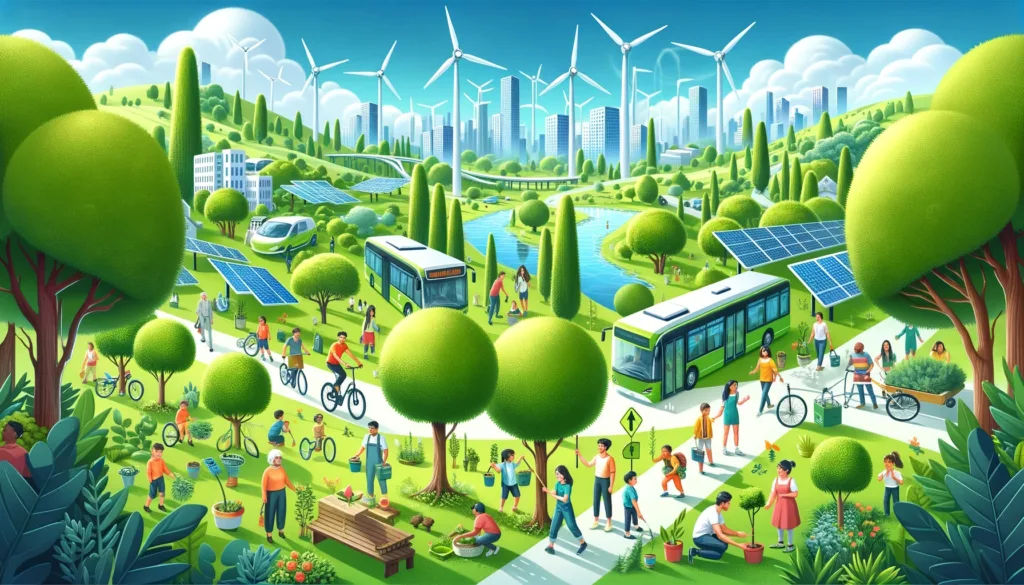As the world continues to grapple with the effects of climate change, it is increasingly clear that we need to find solutions that not only address these issues but also promote a greener and more sustainable future. One often overlooked aspect of this challenge is the importance of improving our math skills in order to effectively tackle these problems.
Mathematics plays a crucial role in understanding the impacts of climate change and identifying sustainable alternatives. It can help us better quantify the scale and scope of these challenges, as well as analyze data and trends to identify patterns and potential solutions. Whether we’re talking about modeling carbon emissions or developing new renewable energy technologies, mathematics is a key tool in finding effective climate change solutions.
Furthermore, math skills are also essential for understanding complex economic systems that drive global climate change. By studying topics such as marginal cost analysis and game theory, we can better understand how to create incentives for sustainable behavior and develop policies that promote green innovation.
Ultimately, improving our collective math skills is an important step towards building a more resilient and sustainable future. By investing in math education and promoting the use of mathematics in tackling climate change, we can create a brighter and more secure future for ourselves and generations to come.
Basic Math Concepts
As we seek solutions to address climate change, understanding basic math concepts like addition, subtraction, multiplication and division becomes increasingly important. These mathematical skills are essential tools that can help us analyze data related to the environment. By understanding how to apply these concepts, we can make informed decisions and develop effective strategies for addressing environmental problems.
Take for example the issue of carbon emissions. To reduce our carbon footprint, we need to understand how much CO2 we are producing and how much we can reduce. This requires basic math skills like addition and subtraction to calculate our current emission levels, as well as multiplication to determine how much we need to cut back.
Real-life examples abound when it comes to applying math concepts to environmental issues. For instance, farmers use mathematical models to predict crop yields based on weather patterns and soil conditions. Hydrologists use calculus to model water flow in rivers and lakes. These are just a few of the many ways that mathematics can be used to solve environmental problems.
Basic math concepts like addition, subtraction, multiplication and division play a crucial role in analyzing data related to climate change. By understanding how to apply these skills, we can make informed decisions and develop effective strategies for addressing environmental problems.
Algebraic Concepts for a Greener Future: Climate Change Solutions
Mathematical models are an essential tool for understanding and predicting climate change. They allow us to model different scenarios and evaluate their impact on our planet. Algebraic concepts, such as equations and expressions, play a crucial role in creating these models.
Equations are used to describe the relationships between different variables in a system. For example, we can use an equation to describe the relationship between carbon dioxide emissions and temperature increase. Expressions, on the other hand, allow us to combine different variables into a single quantity. This is useful when we want to analyze the impact of multiple factors on a particular outcome.
By using mathematical models, we can predict the impacts of different emission reduction strategies. For example, we can use an equation to model the relationship between carbon emissions and global temperature increase. We can then use this model to evaluate the effectiveness of different emission reduction strategies, such as transitioning to renewable energy sources or implementing carbon taxes.
Algebraic concepts are essential for creating mathematical models that can help us better understand and address climate change. By using equations and expressions, we can create accurate predictions about how our actions will impact the planet. As such, it is important for us to develop a deeper understanding of these concepts in order to create effective solutions for a greener future.
As we look towards a greener future, understanding calculus concepts like limits and derivatives becomes increasingly important. These mathematical tools can help us optimize sustainable solutions and find the most cost-effective and efficient ways to reduce our carbon footprint.
Limits are used to define how a function behaves as its input approaches a certain value or infinity. Derivatives, on the other hand, give us an idea of how quickly a function is changing at any given point. Together, these concepts can be used to analyze and optimize various environmental systems, such as energy production and consumption, transportation networks, and land-use planning.
For instance, in renewable energy, calculus can help determine the optimal placement and size of solar panels or wind turbines. This can result in more efficient use of resources and reduced costs for homeowners and businesses alike.
Similarly, optimization techniques like linear programming can be used to identify the most cost-effective and efficient solutions for reducing greenhouse gas emissions. By analyzing factors such as energy production, transportation, and waste management, these models can help policymakers make informed decisions about how best to tackle climate change.
Understanding calculus concepts like limits and derivatives is critical to developing effective strategies for a greener future. With the right tools and techniques, we can work towards reducing our carbon footprint while also promoting sustainability and economic growth.
Statistics and Probability
In order to fully understand climate change and its potential impact on our planet, it’s important to have a solid grasp on statistical concepts and probability theory. By analyzing data using these tools, we can gain insights into the likely outcomes of different scenarios and make more informed decisions about how best to address the problem.
Mean, Median, Mode, and Standard Deviation
- Mean is an average calculated by adding up all values in a set of numbers and dividing by the number of values. It represents the central tendency of a distribution.
- Median is the middle value in a set of numbers. If there are an even number of values, the median is the average of the two middle values.
- Mode is the most common value in a set of numbers.
- Standard deviation measures how spread out the data is from the mean.
Applying these concepts to climate data can provide valuable information about trends and patterns. For example, looking at temperature readings over time can help us identify long-term trends in global temperatures, as well as short-term fluctuations. By analyzing this data using statistical methods, we can determine the average temperature (mean), the most common temperature (mode), and the spread of temperatures around the mean (standard deviation).
Probability Theory
- Probability theory is used to calculate the likelihood of different events occurring. It’s an important tool for analyzing climate change scenarios, as it allows us to estimate the chances of certain outcomes based on historical data and other factors.
For example, we might use probability theory to analyze the likelihood of a particular scenario happening, such as a certain level of sea-level rise or a certain amount of temperature increase. By calculating the probability of different scenarios, we can make informed decisions about how best to mitigate the impacts of climate change.
Statistics and probability theory are powerful tools for understanding and addressing climate change. By applying these concepts to data analysis, we can gain valuable insights into the likely outcomes of different scenarios and make more informed decisions about how best to preserve our planet’s future.
Math in Action
Solving environmental problems requires a deep understanding of mathematics. While many people may view math as abstract and unrelated to real-world issues, it plays an essential role in developing solutions to climate change. We will explore how math is being used in the field and discuss ways for individuals to improve their own math skills to contribute to solving environmental issues.
Real-World Examples
Mathematics has a wide range of applications when it comes to environmental problems. One example is modeling climate change impacts. Climate scientists use mathematical models to predict how our planet will respond to rising temperatures and changes in atmospheric composition. These models allow us to make projections about future conditions, which can inform policy decisions that aim to reduce the effects of global warming.
Another example is using math to develop renewable energy solutions. Engineers use mathematical modeling techniques to design efficient solar panels, wind turbines, and other clean energy technologies. These models allow engineers to optimize designs for maximum efficiency and cost-effectiveness.
Individual Contribution
Improving your own math skills is a great way to contribute to solving environmental problems. Whether you’re interested in becoming an engineer or simply want to understand the science behind climate change, learning more about math can help you make informed decisions about how to reduce your impact on the environment. You can start by taking online courses or attending local events focused on math and the environment. There are also many books available that explore the mathematical concepts underlying environmental problems.

Mathematics plays a critical role in solving environmental problems. From modeling climate change impacts to designing renewable energy solutions, math is essential for developing effective solutions. By improving your own math skills, you can contribute to solving these pressing issues and help create a more sustainable future.
As we come to the end of this post on Math Skills for a Greener Future, I hope that you have learned how important it is to improve our mathematical abilities in order to find effective solutions to combat climate change. Through understanding basic algebra, calculus and statistical concepts, individuals can contribute to finding sustainable solutions that mitigate the impacts of this global issue. Whether you are a student or professional, developing your math skills is an essential tool for creating a greener future for ourselves and our planet.



I didn’t know how much math was involved. That’s like genius level egghead stuff